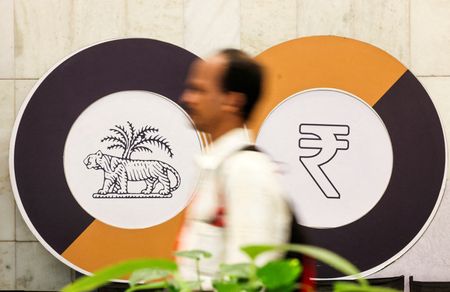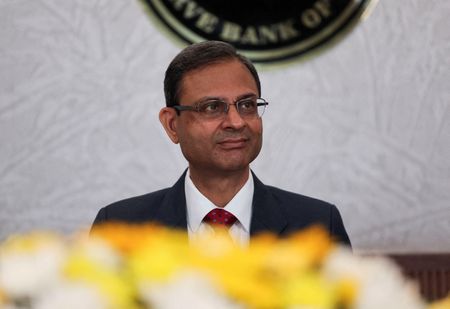By Dharamraj Dhutia and Nimesh Vora
MUMBAI (Reuters) -The Reserve Bank of India’s liquidity infusion via a phased cash reserve ratio cut had less impact than expected as dollar sales and maturing FX forwards drained funds, poising short-term rates for a rise, four analysts said.
In June, the central bank announced a phased 100-basis-points CRR cut from September to November to release about 2.5 trillion rupees ($28.3 billion), but analysts said the liquidity boost has proved far smaller than the expected 1.25 trillion rupees.
“Although the CRR requirement in the banking system has declined, much of this liquidity has been absorbed due to the RBI’s foreign exchange market interventions. As a result, the net liquidity injection has not been substantial,” said Vikas Garg, head of fixed income at Invesco Mutual Fund.
A cut in the CRR frees up funds that banks must otherwise park with the central bank, boosting liquidity and typically easing short-term rates. When that liquidity boost is muted, funding costs can stay high.
Half of the planned CRR cut has taken effect, yet banking system liquidity briefly slipped into deficit last month.
“We have held a view that the CRR cut was not even going to fully offset the FX forward book maturity drain from domestic banking liquidity, and that is playing out,” said Dhiraj Nim, economist and FX strategist at ANZ.
The RBI has $14.45 billion in forwards maturing in October–November after $5.85 billion rolled off in September, while rupee-supporting interventions since late August amid U.S. tariff and visa pressures have further drained liquidity, analysts said.
On Wednesday, the RBI intervened heavily in the currency market to bolster the rupee, mirroring its February strategy.
Post-February, the central bank had initiated significant liquidity infusions, and traders expect a similar approach.
“Today’s intervention has opened up doors for open market purchases, if not immediately, then maybe after the remaining CRR cut takes effect,” said VRC Reddy, treasury head at Karur Vysya Bank.
The daily average banking system liquidity surplus has dropped to 1.3 trillion rupees since September 6, when the first CRR cut took effect, compared to 2.8 trillion rupees between August 1 and September 5.
“If a durable gap emerges, intervention through permanent liquidity tools cannot be ruled out, and if yields do rise sharply, the RBI can step in with OMOs,” ANZ’s Nim added.
($1 = 88.3520 Indian rupees)
(Reporting by Dharamraj Dhutia and Nimesh Vora; Editing by Nivedita Bhattacharjee)











